John Shelley's Blog, page 12
October 28, 2013
Stone Giant
The Giant has awoke!
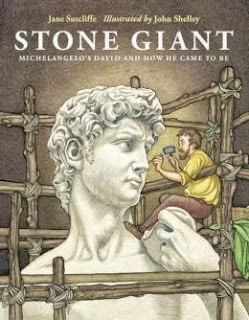
Cover, US edition
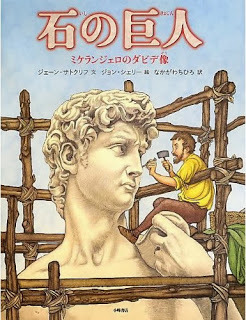
Cover, Japanese edition
Stone Giant - Michelangelo's David and How He Came to Be, written by Jane Sutcliffe, has been my biggest illustration project of the last year. Although the book was commissioned from the US, the first version to hit the shops is in Japanese - in order to tie in with a major exhibition of Michelangelo's work at the National Museum of Western Art in Tokyo, Komine Shoten have fast released their edition of the book in advance, it's now on sale throughout Japan. The originally commissioned English language edition from Charlesbridge in the US will be out next spring (ISBN: 978-1-58089-295-7), but is already available for pre-order from your local independent bookshop, or Random House, Amazon, Foyles, Barnes and Noble and other online sites.
Anyway, I thought it was about time I started yelling about it! The images here are scans of artwork spreads before print, in the final book several have seperately drawn text boxes dropped over.
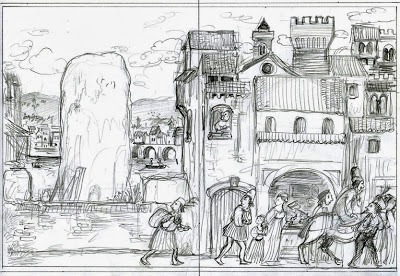
First spread, initial sketch. I originally envisaged the stoneyard close to the river, with a glimpse of the bridges behind.
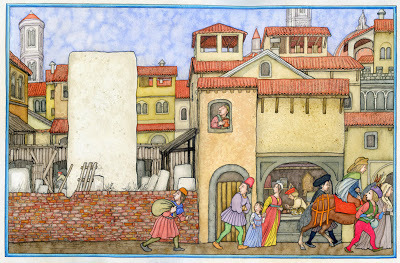
Completed image. My editor pointed out that the yard was probably close to the cathedral rather than the river, so the background was changed.
As the title indicates, Stone Giant is a non-fiction picture book telling the story of how the statue of David was first commissioned and an enormous block of marble cut, but after some limited attempts by obscure artists the project was abandoned and the flawed stone left forgotten and abandoned in a stonemason's yard for over 40 years. Finally the young Michelangelo came along to carve the statue and create one of his greatest masterpieces.
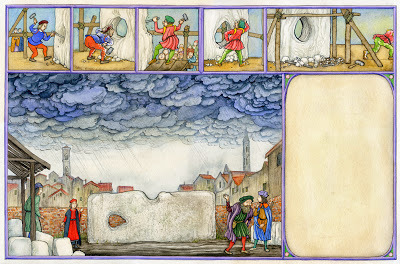
The stone is worked on by inferior artists then abandoned, even Leonardo turns down the commission.
This was a really wonderful project to work on, the history, the subject, and the location all connected with me very much. It was a joy to research. I closely examined as many contemporary paintings and other references as I could and spent a long time accumulating material for costume and setting, involving many hours in the library and online. The more I delved into the era, the more I connected, the more I was compelled to instill the illustrations with a flavour of the period.
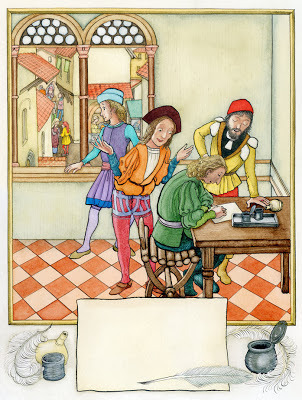
There were many sketches, numerous revisions, but slowly the book began to emerge, just like David himself emerging from the rough rock. I became completely absorbed in the world of Renaissance Italy and of Michelangelo. This is what I really love about illustrating books, you mentally inhabit the worlds you create.
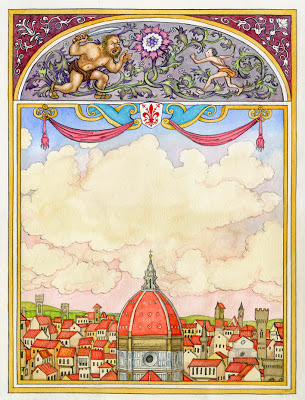
One of two panels inspired by Renaissance designs
I incorporated a number of motifs and decorative devices inspired by Renaissance works. The aim was to make the book a fun, contemporary read for children, whilst connecting with the art of the period.
I wasn't afraid to use the ultimate device: line-for-line facsimiles of Michelangelo's sketches. Oh, the impertinence! I wanted to show his work of course, but it had to be in the same pen and watercolour as the rest of the spreads, so I tried my hand at reproducing his work with my own materials. These were drawn in homage to the master, I hope the ghost of the great man will rest easy!
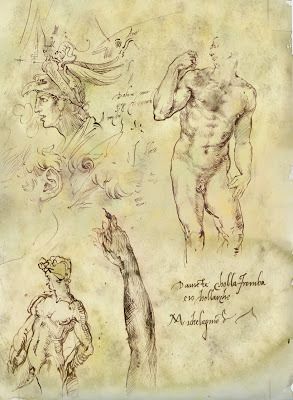
Michelangelo? Erm, well ....
Another challenge was the depiction of Michelangelo at work on the statue. I based my stone cutters yard loosely on a painting by Canaletto, with a good dose of conjecture. It's known that Michelangelo built a wooden shed around the stone to protect it while he worked and keep out prying eyes, however experts don't entirely agree how the statue was carved - was it laid out at an angle or carved upright, or flat? I used my imagination to fill in the gaps and settled for the most striking visual appeal, this is how he may have worked, we'll probably never know the actual truth.
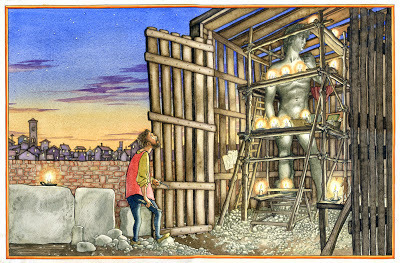
Not everything is exactly as reality, some things were designed purely for visual effect, for instance the wall of the Palazzo Vecchio isn't really blue!
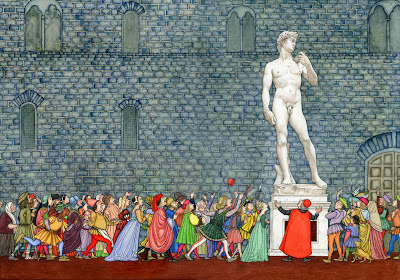
the statue is revealed!
Then there is the town. I'm quite familiar with modern Florence, but one of the biggest challenges was depicting the city as it appeared at the beginning of the 16th Century. This climatic spread was a particular conundrum, as I wanted to show a specific scene as Michelangelo would have known it, but virtually all of these buildings were demolished after Michelangelo's era, and there are very few references.
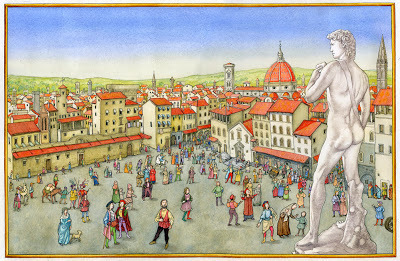
The statue in this illustration is elevated much higher than it actually stood - that's a deliberate compositional device I make no apologies for! But the rest of the image is an attempt to show the Piazza della Signoria as it was, facing away from the Palazzo Vecchio, with the cathedral in view. However virtually all contemporary depictions of the square are facing the opposite direction towards the Palazzo Vecchio and Loggia dei Lanzi, away from the more run-down west side.
My main sources were later images by Giuseppe Zocchi showing an oblique view of the old Loggia dei Pisani, the wall of the merchants (demolished in the 19th Century), and another by Bernardo Bellotto showing a glimpse of the church of San Romolo, also long vanished, pulled down in 1769. Using these references and a few others I was able to plan out, turn around and draw in a series of sketches of the buildings from a completely different angle. This felt like real historical research, I hope the experts are satisfied!
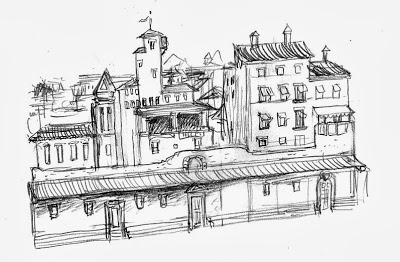
preparatory sketch of the Loggia dei Pisani and buildings sourced from Zocchi's works and turned around.
Therein lies the problem of research using old paintings - they can never quite tell the whole story, only glimpses through the eyes and materials of the original artist. So when you're looking for authenticity, often the more you find, the deeper you have to look in order to "nail it", to reassure yourself that you've got it right. It's easy to spend entire days chasing references for some minor detail, at some point you have to stop searching and start drawing, so unless you're literally copying an image (not recommended, the facsimiles above are an exception!) then there will always be need to cross-reference, invent, re-interpret and imagine parts of a scene. The resulting illustration is therefore a matching of your imagination with that of the artists' you source.
I aimed for a believably authentic feel, inputting accurate research for those spreads that required it. How did I do?
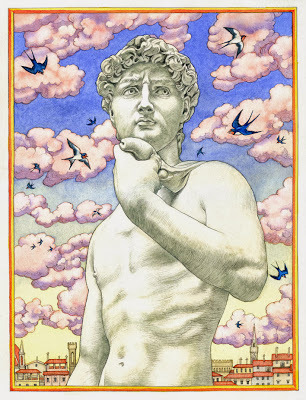
The Japanese edition, 石の巨人 (Ishi no Kyojin) is available now from Komine Shoten publishers.
English language US Edition of Stone Giant with Jane Sutcliffe's wonderful text is published on 8th April 2014 from Charlesbridge/Random House, available for pre-order now, ISBN: 978-1-58089-295-7.

Cover, US edition

Cover, Japanese edition
Stone Giant - Michelangelo's David and How He Came to Be, written by Jane Sutcliffe, has been my biggest illustration project of the last year. Although the book was commissioned from the US, the first version to hit the shops is in Japanese - in order to tie in with a major exhibition of Michelangelo's work at the National Museum of Western Art in Tokyo, Komine Shoten have fast released their edition of the book in advance, it's now on sale throughout Japan. The originally commissioned English language edition from Charlesbridge in the US will be out next spring (ISBN: 978-1-58089-295-7), but is already available for pre-order from your local independent bookshop, or Random House, Amazon, Foyles, Barnes and Noble and other online sites.
Anyway, I thought it was about time I started yelling about it! The images here are scans of artwork spreads before print, in the final book several have seperately drawn text boxes dropped over.

First spread, initial sketch. I originally envisaged the stoneyard close to the river, with a glimpse of the bridges behind.

Completed image. My editor pointed out that the yard was probably close to the cathedral rather than the river, so the background was changed.
As the title indicates, Stone Giant is a non-fiction picture book telling the story of how the statue of David was first commissioned and an enormous block of marble cut, but after some limited attempts by obscure artists the project was abandoned and the flawed stone left forgotten and abandoned in a stonemason's yard for over 40 years. Finally the young Michelangelo came along to carve the statue and create one of his greatest masterpieces.

The stone is worked on by inferior artists then abandoned, even Leonardo turns down the commission.
This was a really wonderful project to work on, the history, the subject, and the location all connected with me very much. It was a joy to research. I closely examined as many contemporary paintings and other references as I could and spent a long time accumulating material for costume and setting, involving many hours in the library and online. The more I delved into the era, the more I connected, the more I was compelled to instill the illustrations with a flavour of the period.

There were many sketches, numerous revisions, but slowly the book began to emerge, just like David himself emerging from the rough rock. I became completely absorbed in the world of Renaissance Italy and of Michelangelo. This is what I really love about illustrating books, you mentally inhabit the worlds you create.

One of two panels inspired by Renaissance designs
I incorporated a number of motifs and decorative devices inspired by Renaissance works. The aim was to make the book a fun, contemporary read for children, whilst connecting with the art of the period.
I wasn't afraid to use the ultimate device: line-for-line facsimiles of Michelangelo's sketches. Oh, the impertinence! I wanted to show his work of course, but it had to be in the same pen and watercolour as the rest of the spreads, so I tried my hand at reproducing his work with my own materials. These were drawn in homage to the master, I hope the ghost of the great man will rest easy!

Michelangelo? Erm, well ....
Another challenge was the depiction of Michelangelo at work on the statue. I based my stone cutters yard loosely on a painting by Canaletto, with a good dose of conjecture. It's known that Michelangelo built a wooden shed around the stone to protect it while he worked and keep out prying eyes, however experts don't entirely agree how the statue was carved - was it laid out at an angle or carved upright, or flat? I used my imagination to fill in the gaps and settled for the most striking visual appeal, this is how he may have worked, we'll probably never know the actual truth.

Not everything is exactly as reality, some things were designed purely for visual effect, for instance the wall of the Palazzo Vecchio isn't really blue!

the statue is revealed!
Then there is the town. I'm quite familiar with modern Florence, but one of the biggest challenges was depicting the city as it appeared at the beginning of the 16th Century. This climatic spread was a particular conundrum, as I wanted to show a specific scene as Michelangelo would have known it, but virtually all of these buildings were demolished after Michelangelo's era, and there are very few references.

The statue in this illustration is elevated much higher than it actually stood - that's a deliberate compositional device I make no apologies for! But the rest of the image is an attempt to show the Piazza della Signoria as it was, facing away from the Palazzo Vecchio, with the cathedral in view. However virtually all contemporary depictions of the square are facing the opposite direction towards the Palazzo Vecchio and Loggia dei Lanzi, away from the more run-down west side.
My main sources were later images by Giuseppe Zocchi showing an oblique view of the old Loggia dei Pisani, the wall of the merchants (demolished in the 19th Century), and another by Bernardo Bellotto showing a glimpse of the church of San Romolo, also long vanished, pulled down in 1769. Using these references and a few others I was able to plan out, turn around and draw in a series of sketches of the buildings from a completely different angle. This felt like real historical research, I hope the experts are satisfied!

preparatory sketch of the Loggia dei Pisani and buildings sourced from Zocchi's works and turned around.
Therein lies the problem of research using old paintings - they can never quite tell the whole story, only glimpses through the eyes and materials of the original artist. So when you're looking for authenticity, often the more you find, the deeper you have to look in order to "nail it", to reassure yourself that you've got it right. It's easy to spend entire days chasing references for some minor detail, at some point you have to stop searching and start drawing, so unless you're literally copying an image (not recommended, the facsimiles above are an exception!) then there will always be need to cross-reference, invent, re-interpret and imagine parts of a scene. The resulting illustration is therefore a matching of your imagination with that of the artists' you source.
I aimed for a believably authentic feel, inputting accurate research for those spreads that required it. How did I do?

The Japanese edition, 石の巨人 (Ishi no Kyojin) is available now from Komine Shoten publishers.
English language US Edition of Stone Giant with Jane Sutcliffe's wonderful text is published on 8th April 2014 from Charlesbridge/Random House, available for pre-order now, ISBN: 978-1-58089-295-7.
Published on October 28, 2013 01:34
October 22, 2013
News Without Words
Last Sunday the biggest daily newspaper in Japan, Mainichi Shinbun, included a special pull-out poster feature - Moji no Nai News "News Without Words", consisting of a large map of the
world showing current events, local features and so on. I created the whole poster map, with direction from Tokyo Planet Design.
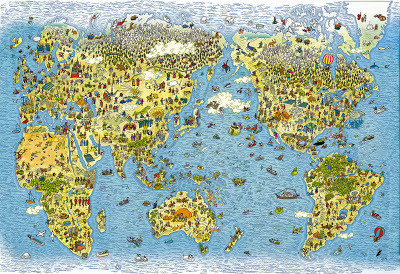
the published map
There is a lot of detail to see, the best way to view it is with the zoom-in online version here! (click on the image to bring up the zoomable version).
Sunday was "Grandparents Day" in Japan, the idea behind the map was to present news visually in a way that could be shared between grandparents and grandchildren. This turned out to be a tremendous amount of work, as I was required to create the artwork at very large size, and, as it needed to include current news events, would probably require redraw edits right up until the press day. I was given a number of key news items to include, but for several big regions I had no briefing, so ended up doing a lot of my own research for things to fill in.

Australia, (original colouring before final edit)
I was also asked to render it in the same style as a small watercolour from one of my exhibitions, a very different kind of picture, which led to a lot of head scratching! I estimated the project would take around 3 weeks; in fact it stretched to almost 6 weeks of intensive activity.
I first drew the background land map and wave texture for the sea in pen and ink on 16 sheets of A3 layout paper, which were scanned and matched together in Photoshop. I scanned in my own large watercolour textures for the sea and land to provide a rich coloured background. If I were to put the sheets together, the picture at actual size would be around 1.5 by 1 metres.
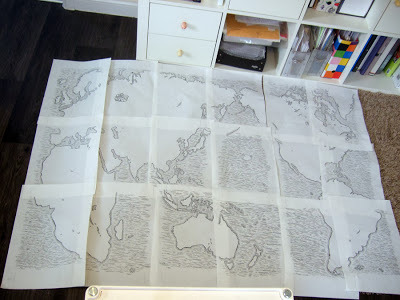
The background world
The figures and other details were then drawn individually in pen and ink and scanned in, one by one, positioned and flattened into another layer - there were many separate drawings, not all of which made it to the final illustration, and much repositioning. This is the standard way I work with computers nowadays, scanning in hand drawn linework and textures, arranging and colouring, however this was on a rather grand scale. It felt very much like illustration by jigsaw puzzle.
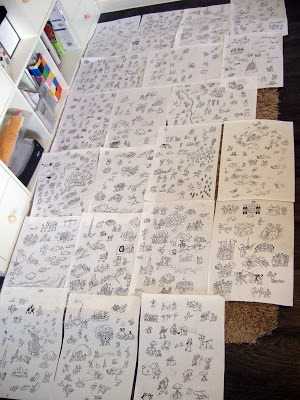
Some of the sheets for the figures
When everything was assembled on screen the file came to 1.5 gigabytes, largely due to the heavy data watercolour backgrounds! The last touch was to add extra landscape features drawn directly on the computer with a Wacom pen.
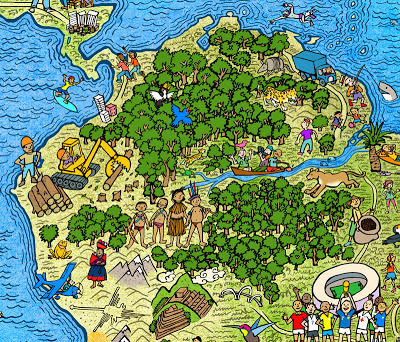
The Amazon (original colouring as delivered)
As anticipated, there were many editorial changes right up to the last minute, even after I delivered the finished artwork, figures were taken out or replaced, enlarged or reduced (especially Japan - I was sad to see my Ainu man was removed from Hokkaido!). Also, at the very last minute the client decided to greatly lighten the colours, my original watercolour textures were smoothed out to a much flatter finish. Hmm, I personally prefer the deeper colours you see here, but this was a commissioned piece and my job is to provide what the client requires - in these instances, the client is always right!
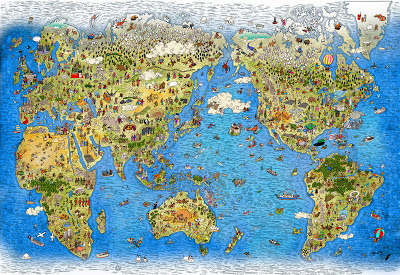
The colour scheme as I delivered it. Compare to the one above or the online version. Which do you prefer?
Although I was given a number of news items to include, there are many other details and large tracts of land which I had no brief for and so researched and filled in myself. I aimed for a balance between news, gentle humour and regional ecology.

East Coast North America (original colouring as delivered)

The Middle East (original colouring as delivered)
Self portraits? Of course!
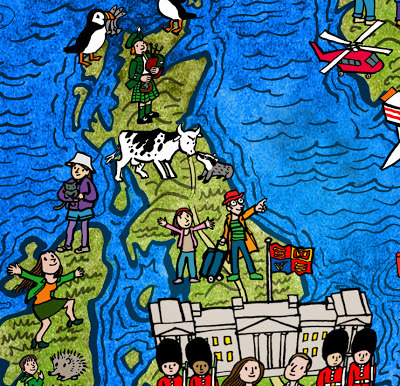
With daughter in England. Squeezed north by the Royal Baby. Ayup!
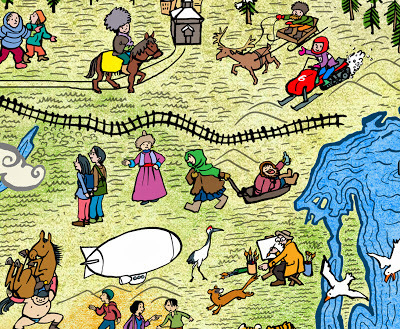
Did you know "sable" watercolour brushes are actually from Siberian weasels?
The online zoomable version is still accessible here!
world showing current events, local features and so on. I created the whole poster map, with direction from Tokyo Planet Design.

the published map
There is a lot of detail to see, the best way to view it is with the zoom-in online version here! (click on the image to bring up the zoomable version).
Sunday was "Grandparents Day" in Japan, the idea behind the map was to present news visually in a way that could be shared between grandparents and grandchildren. This turned out to be a tremendous amount of work, as I was required to create the artwork at very large size, and, as it needed to include current news events, would probably require redraw edits right up until the press day. I was given a number of key news items to include, but for several big regions I had no briefing, so ended up doing a lot of my own research for things to fill in.

Australia, (original colouring before final edit)
I was also asked to render it in the same style as a small watercolour from one of my exhibitions, a very different kind of picture, which led to a lot of head scratching! I estimated the project would take around 3 weeks; in fact it stretched to almost 6 weeks of intensive activity.
I first drew the background land map and wave texture for the sea in pen and ink on 16 sheets of A3 layout paper, which were scanned and matched together in Photoshop. I scanned in my own large watercolour textures for the sea and land to provide a rich coloured background. If I were to put the sheets together, the picture at actual size would be around 1.5 by 1 metres.

The background world
The figures and other details were then drawn individually in pen and ink and scanned in, one by one, positioned and flattened into another layer - there were many separate drawings, not all of which made it to the final illustration, and much repositioning. This is the standard way I work with computers nowadays, scanning in hand drawn linework and textures, arranging and colouring, however this was on a rather grand scale. It felt very much like illustration by jigsaw puzzle.

Some of the sheets for the figures
When everything was assembled on screen the file came to 1.5 gigabytes, largely due to the heavy data watercolour backgrounds! The last touch was to add extra landscape features drawn directly on the computer with a Wacom pen.

The Amazon (original colouring as delivered)
As anticipated, there were many editorial changes right up to the last minute, even after I delivered the finished artwork, figures were taken out or replaced, enlarged or reduced (especially Japan - I was sad to see my Ainu man was removed from Hokkaido!). Also, at the very last minute the client decided to greatly lighten the colours, my original watercolour textures were smoothed out to a much flatter finish. Hmm, I personally prefer the deeper colours you see here, but this was a commissioned piece and my job is to provide what the client requires - in these instances, the client is always right!

The colour scheme as I delivered it. Compare to the one above or the online version. Which do you prefer?
Although I was given a number of news items to include, there are many other details and large tracts of land which I had no brief for and so researched and filled in myself. I aimed for a balance between news, gentle humour and regional ecology.

East Coast North America (original colouring as delivered)

The Middle East (original colouring as delivered)
Self portraits? Of course!

With daughter in England. Squeezed north by the Royal Baby. Ayup!

Did you know "sable" watercolour brushes are actually from Siberian weasels?
The online zoomable version is still accessible here!
Published on October 22, 2013 04:22
October 12, 2013
Catching up!
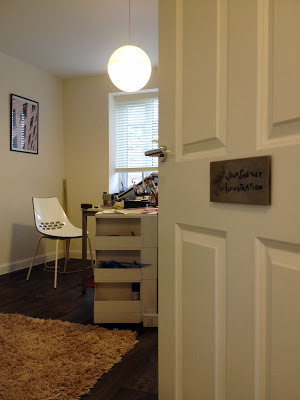
New studio, open for business!
Ah, back at last!! I've been avoiding social media for a time, chiefly due to a series of hurdles following our big house move, volunteer commitments, and recently more than anything just catching up with illustration deadlines. These last three weeks in particular have seen the studio candles burning very late into the night on my latest job, in fact through the night on a couple of occasions, all for a single newspaper job. I'll talk about this in full once it's gone to press, but here's some sneaky details, it's a large map of the world...
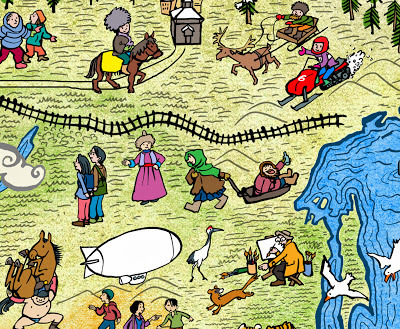
land of sables, cold vodka and horse wrestlers
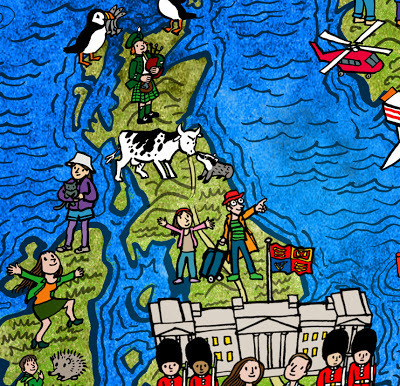
...yes, self portraits sneaked in!
Blimey, so much has happened over the summer - new book, new poster, a bunch of other illustrations, so much to talk about.
With the pressure mounting then, I deliberately stepped back from social media until much of this was sorted, so I was on hiatus from mail groups, Facebook, Twitter and other cyber distractions including blogs, at least until things were more settled.
But now, finally, I'm on top of deadlines, daughter and I are comfortably moved into our new home, with new studio, and a new assistant.....
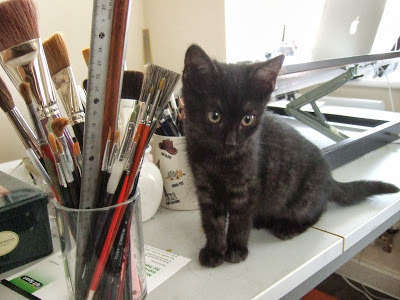
Our little Pixie is not much help with achieving deadlines, but she's learning, never under estimate fairy folk. I'm confident she'll be wielding a paint brush soon enough!
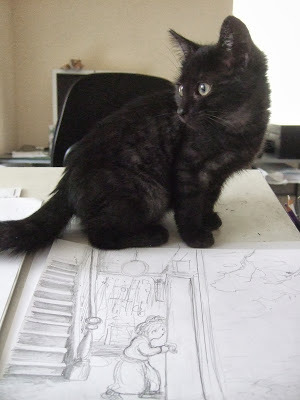
Published on October 12, 2013 07:42
July 10, 2013
Summer Greetings
Wishing all of my friends and readers a fabulously lush and verdant summer!
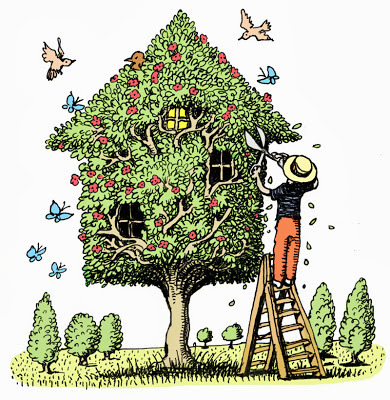
As some will know, I've recently moved house just in time for the sunshine. It's a brand new house right on the very edge of the city of Norwich, so we're surrounded by a building site at the moment, with bright yellow diggers roaring past my door, and a constant cacophony of clanging and banging all day. But when all is settled life here will be a rustic dream of bucolic calm...
....Or at least so I'm dreaming.
What I can definitely say for sure is that, apart from a few issues when we moved in, this house is just about perfect for the requirements of a madcap artist and his wild-eyed daughter. This is going to be great.
Happy summer everyone!

As some will know, I've recently moved house just in time for the sunshine. It's a brand new house right on the very edge of the city of Norwich, so we're surrounded by a building site at the moment, with bright yellow diggers roaring past my door, and a constant cacophony of clanging and banging all day. But when all is settled life here will be a rustic dream of bucolic calm...
....Or at least so I'm dreaming.
What I can definitely say for sure is that, apart from a few issues when we moved in, this house is just about perfect for the requirements of a madcap artist and his wild-eyed daughter. This is going to be great.
Happy summer everyone!
Published on July 10, 2013 12:03
June 4, 2013
The Grimm Road
This year celebrates the 200th anniversary of the publication of the Grimm Brother's Household Tales. To commemorate, here's my latest editorial cut from the regular series of monthly illustrations I draw for ANA's in-flight magazine Wingspan.
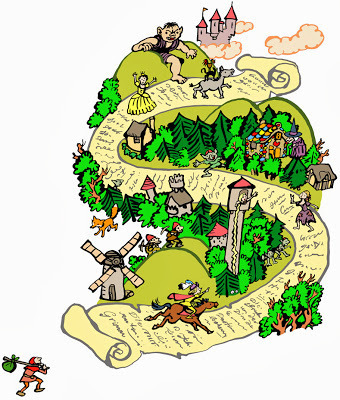
It's in the June issue, but you have to fly on one of ANA's international flights to find the magazine!

It's in the June issue, but you have to fly on one of ANA's international flights to find the magazine!
Published on June 04, 2013 11:17
May 27, 2013
Some more images of Yanesen in 1987-88
Here are some more comparison photos of lost Yanaka and Nezu, "then and now".
Over the years I experienced a lot of things in Japan, many of them amazing, and occasionally disturbing. There have been a few things that truly shocked me, but the destruction of the old buildings of Yanesen is really heartbreaking.
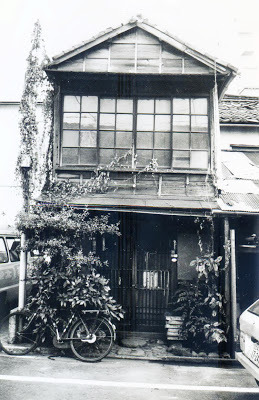
Nezu 2-chome 10 banchi in 1987
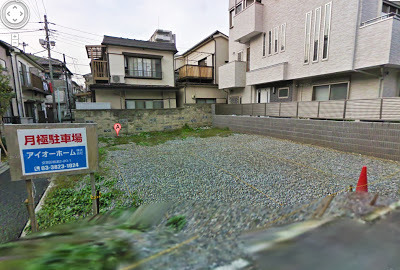
Nezu 2-chome 10 banchi today (Google Street view)
Yanesen was not like other areas, it was a survivor, with a culture and charm of it's own. Because the
district was so untouched, every old building had a value to the town
beyond it's own land price. Each one that is pulled down now is a
destruction not only of the property, but of the heritage of the area. In a few years Yanesen will be just another faceless Tokyo suburb in the urban sprawl.
And what are these old buildings being replaced by? Often it's very little, and sometimes it's nothing at all!
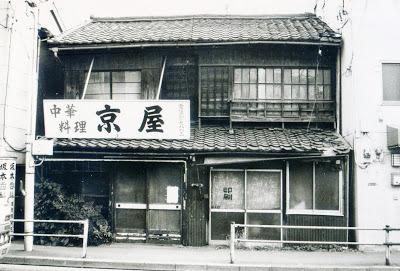
Ueno Sakuragi 1-11-12 in 1987. Chinese restaurant Kyoya
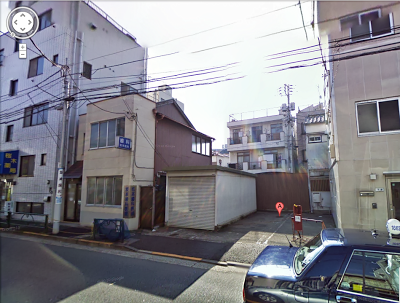
the same location today (Google)
Why is this? It's all to do with land taxes - people inherit these properties and find they simply can't afford to pay the property taxes to maintain them, so they're torn down and replaced by car parks, or cheap prefab storage units, or the land is simply left bare.
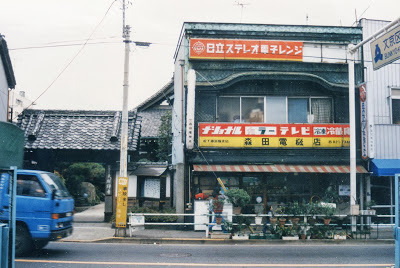
Yanaka 1-2 in 1987, the entrance to Tengenji Temple on Kototoi-dori and Morita Electricals shop, which stood just a couple of doors along from Shin-Fuji Soba
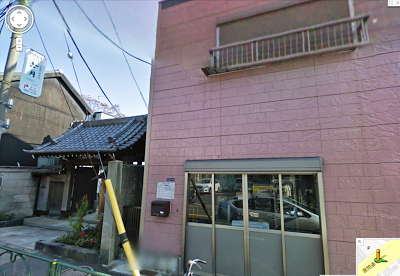
Morita Electricals was demolished in 2003 and replaced by this structure (Google)
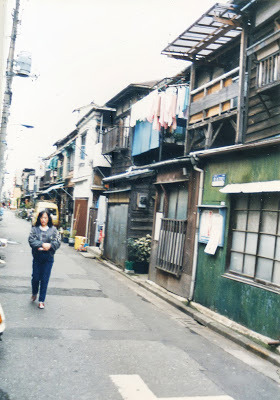
Nezu 2 chome 21 banchi in 1987....
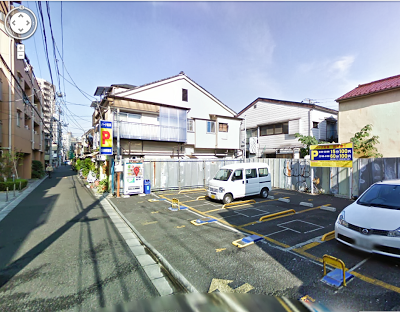
.... and the same location as a car park today (Google)
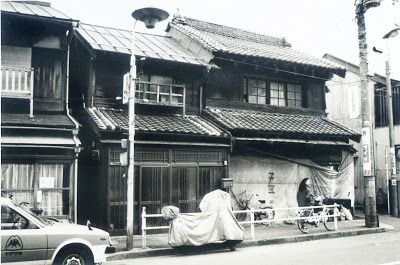
Nezu 2-chome 31 banchi in 1987
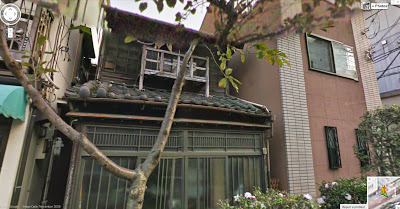
today only the centre structure survives (Google)
One of the most saddening locations for me is the little crossroads between 2-33 Nezu and 2-3 and 2-4 Yanaka. In my last post I showed a snapshot from 1987 showing a line of lost buildings at 2-33 Nezu, here's another photo of the same buildings.
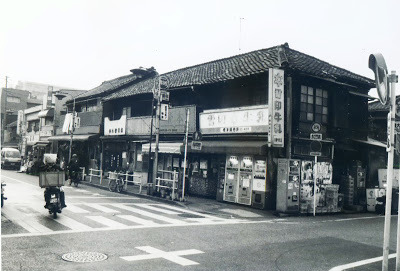
Nezu 2-chome 33 banchi in 1987
If you turned and walked right at the crossing you would soon find on the left hand side Yoshinoya Sake-ten...
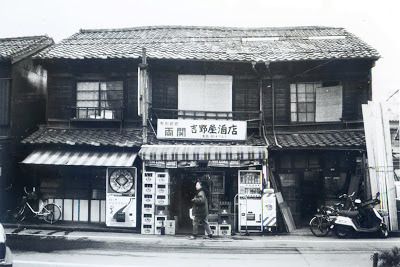
Nezu 2-chome 33 banch, Yoshinoya Sake-ten (1987)
Right next to Yoshinoya was this building...
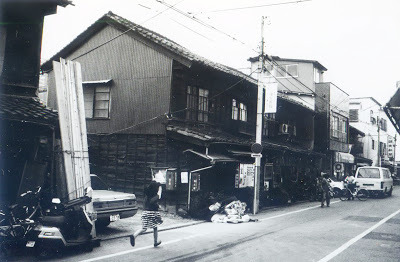
Nezu 2-chome 33 banchi (1987)
So there was a long continuation of wooden traditional buildings that wrapped around the corner and stretched all the way along the block. Now all of this is gone. The buildings above have been pulled down and been replaced by a large modern 'mansion' condominium...
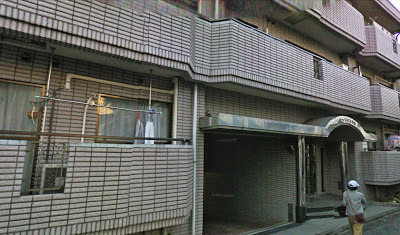
Nezu 2-chome 33 banchi today, Sunrise Nezu Apartment Block (Google)
Not all is lost just yet however. Back at the crossing the line of buildings at 2-33 Nezu continued over to the Shi gen'nagaya tenement at 2-4 Yanaka.
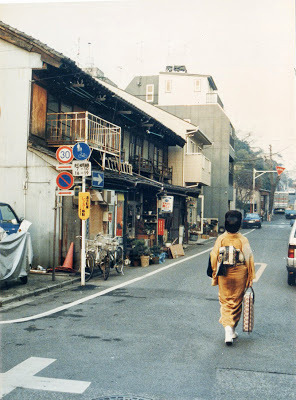
Yanaka 2-chome 4 banchi, Shi gen'nagaya tenement, 1987
Today this still stands, a solitary reminder of former times.
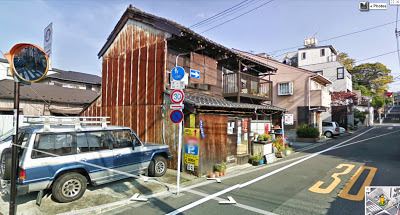
Yanaka 2-chome 4 banchi, Shi gen'nagaya tenement, today
Walking from the crossing in the opposite direction from Yoshinoya towards Kototoi-dori, we can still find the traditional indigo dye shop Chojiya. Thank goodness not all is lost!
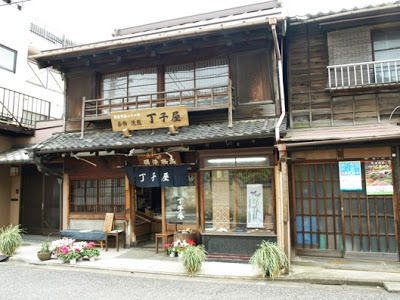
Nezu 2-chome 32 banchi, Chojiya
This is a beautiful, well preserved building, only a few years ago much of the surrounding neighbourhood was the same.
In some cases the building still exists but has been given a modern make-over...
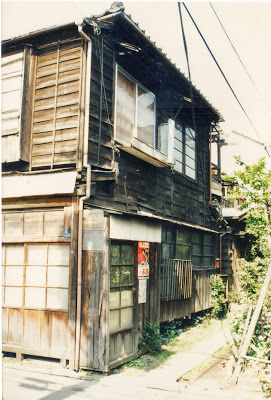
Yanaka 7-17-11, snapped in 1987
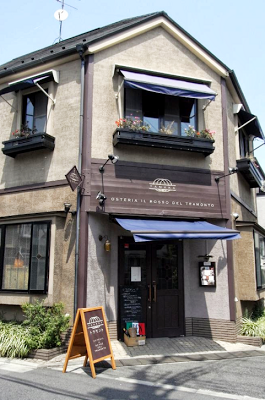
Today the building has evolved into the Italian restaurant Osteria Yanaka no Tramonto
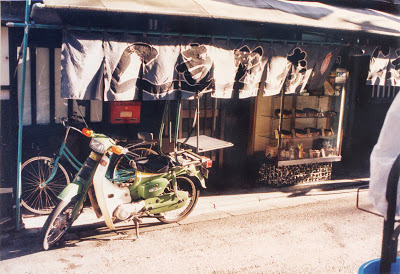
Nezu 2-21, Yoshino Sushi (1987)
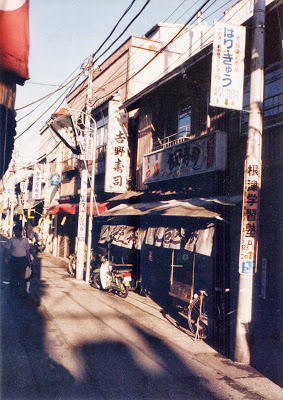
Nezu 2-21, Yoshino Sushi (1987)
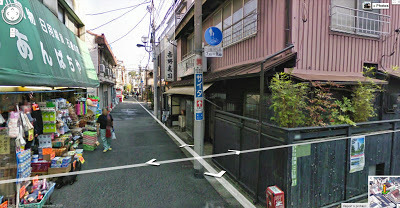
Nezu 2-21, Yoshino Sushi (2013, Google)
Finally, ending on a positive note, it's not all bad news, there are still many old buildings that survive remarkably unchanged. Rather than posting more photos here, a good web search for Yanesen, Yanaka and Nezu will show a lot of these, some are notable traditional businesses and thus hopefully will be preserved. I'll just end my little tour of lost Yanesen with a couple of well known surviving properties I was very familiar with, right around the corner from my old apartment....
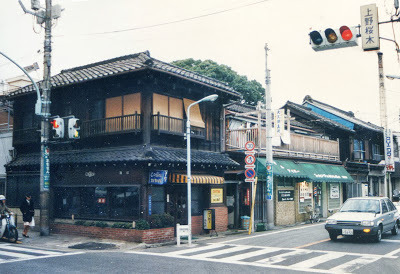
Yanaka 6-chome 1 bancho, Kayaba Coffee Shop in 1987
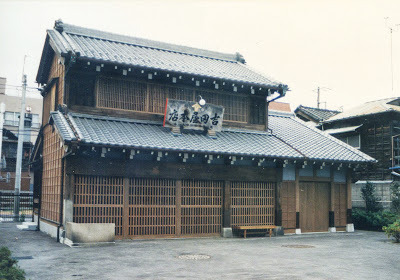
and on the other side of the junction, the Shitamachi Fuzoku Shiryokan Museum
Though the structures next to the coffee shop have all gone, these two buildings still stand proudly today.
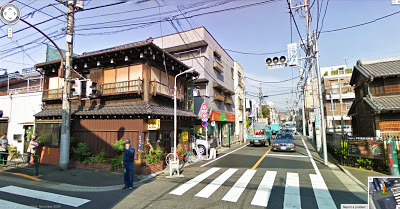
Yanaka 6-chome 1 bancho today (Google)
At least some of my old memories survive! And long may they remain.
Over the years I experienced a lot of things in Japan, many of them amazing, and occasionally disturbing. There have been a few things that truly shocked me, but the destruction of the old buildings of Yanesen is really heartbreaking.

Nezu 2-chome 10 banchi in 1987

Nezu 2-chome 10 banchi today (Google Street view)
Yanesen was not like other areas, it was a survivor, with a culture and charm of it's own. Because the
district was so untouched, every old building had a value to the town
beyond it's own land price. Each one that is pulled down now is a
destruction not only of the property, but of the heritage of the area. In a few years Yanesen will be just another faceless Tokyo suburb in the urban sprawl.
And what are these old buildings being replaced by? Often it's very little, and sometimes it's nothing at all!

Ueno Sakuragi 1-11-12 in 1987. Chinese restaurant Kyoya

the same location today (Google)
Why is this? It's all to do with land taxes - people inherit these properties and find they simply can't afford to pay the property taxes to maintain them, so they're torn down and replaced by car parks, or cheap prefab storage units, or the land is simply left bare.

Yanaka 1-2 in 1987, the entrance to Tengenji Temple on Kototoi-dori and Morita Electricals shop, which stood just a couple of doors along from Shin-Fuji Soba

Morita Electricals was demolished in 2003 and replaced by this structure (Google)

Nezu 2 chome 21 banchi in 1987....

.... and the same location as a car park today (Google)

Nezu 2-chome 31 banchi in 1987

today only the centre structure survives (Google)
One of the most saddening locations for me is the little crossroads between 2-33 Nezu and 2-3 and 2-4 Yanaka. In my last post I showed a snapshot from 1987 showing a line of lost buildings at 2-33 Nezu, here's another photo of the same buildings.

Nezu 2-chome 33 banchi in 1987
If you turned and walked right at the crossing you would soon find on the left hand side Yoshinoya Sake-ten...

Nezu 2-chome 33 banch, Yoshinoya Sake-ten (1987)
Right next to Yoshinoya was this building...

Nezu 2-chome 33 banchi (1987)
So there was a long continuation of wooden traditional buildings that wrapped around the corner and stretched all the way along the block. Now all of this is gone. The buildings above have been pulled down and been replaced by a large modern 'mansion' condominium...

Nezu 2-chome 33 banchi today, Sunrise Nezu Apartment Block (Google)
Not all is lost just yet however. Back at the crossing the line of buildings at 2-33 Nezu continued over to the Shi gen'nagaya tenement at 2-4 Yanaka.

Yanaka 2-chome 4 banchi, Shi gen'nagaya tenement, 1987
Today this still stands, a solitary reminder of former times.

Yanaka 2-chome 4 banchi, Shi gen'nagaya tenement, today
Walking from the crossing in the opposite direction from Yoshinoya towards Kototoi-dori, we can still find the traditional indigo dye shop Chojiya. Thank goodness not all is lost!

Nezu 2-chome 32 banchi, Chojiya
This is a beautiful, well preserved building, only a few years ago much of the surrounding neighbourhood was the same.
In some cases the building still exists but has been given a modern make-over...

Yanaka 7-17-11, snapped in 1987

Today the building has evolved into the Italian restaurant Osteria Yanaka no Tramonto

Nezu 2-21, Yoshino Sushi (1987)

Nezu 2-21, Yoshino Sushi (1987)

Nezu 2-21, Yoshino Sushi (2013, Google)
Finally, ending on a positive note, it's not all bad news, there are still many old buildings that survive remarkably unchanged. Rather than posting more photos here, a good web search for Yanesen, Yanaka and Nezu will show a lot of these, some are notable traditional businesses and thus hopefully will be preserved. I'll just end my little tour of lost Yanesen with a couple of well known surviving properties I was very familiar with, right around the corner from my old apartment....

Yanaka 6-chome 1 bancho, Kayaba Coffee Shop in 1987

and on the other side of the junction, the Shitamachi Fuzoku Shiryokan Museum
Though the structures next to the coffee shop have all gone, these two buildings still stand proudly today.

Yanaka 6-chome 1 bancho today (Google)
At least some of my old memories survive! And long may they remain.
Published on May 27, 2013 08:00
May 20, 2013
Memories of Yanesen
My fascination with Japan originally stemmed from a love of
Ukiyo-e
woodblock prints and the history of old Tokyo, which soon expanded into a wider appreciation of the country. So when in the new year of 1987 I eventually set off to Japan I was determined to live in an area with historical connections to "old Edo" (Edo is the old name for the city).
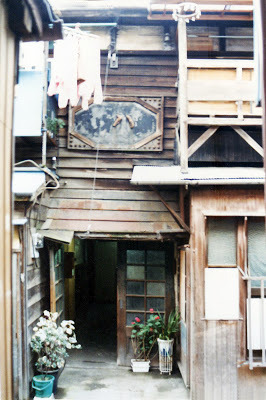
A forgotten corner of Yanaka or Nezu in 1987
This actually proved more difficult than I'd imagined, as my very first residence, provided by my erstwhile sponsor, was right out on the very edge of Tokyo in a new town that was even younger than me. It took a few months before I could eventually find a place of my own choosing, by which time I'd had plenty of time to explore the old districts of the city. From the moment I first walked around Yanaka I fell in love with the area and knew this was where I wanted to live.
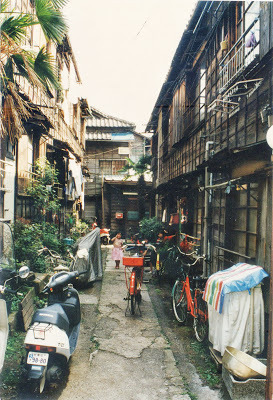
A typical scene in Yanaka in the 1980's. What is it like today I wonder?
The three districts of Yanaka, Nezu and Sendagi span the borders of Taito-ku and Bunkyo-ku wards, and together are known as the Yanesen district. Though part of the old city of Edo, Yanesen was always distinguished as a separate town of temples and shrines. Crucially, it was untouched by the 1923 earthquake and wartime bombing, so still retained much of it's ancient character, with numerous traditional wooden houses dispersed amongst the popular religious locations in the area. More residential and altogether more serene than the noisier jumble of other shitamachi (downtown) areas like Asakusa, Yanesen seems an oasis, full of cultural charm, surrounded by, but somewhat apart from the modern city, a bridge between old Edo and modern Tokyo, with a large number of traditional shops and businesses surviving. Or at least, so it was when I moved there in the Spring of 1987.
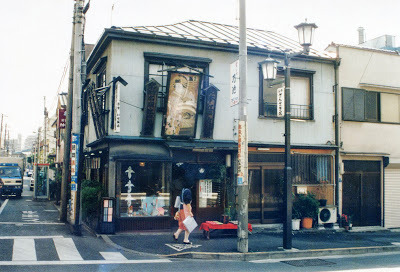
A favorite shop of mine, Isetatsu in Sendagi, famous as a specialist in Japanese paper. The shop is virtually unchanged today.
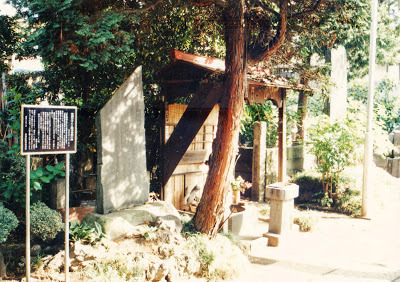
Memorial to one of my favorite Ukiyo-e woodblock print masters, Suzuki Harunobu (1725-70), and his muse Kasamori Osen (1751-1827), in Dai'enji Temple, Sendagi
Finding a place to live there was difficult though, because many rental real estate offices simply would not deal with foreigners, claiming they "had nothing available" before I'd even told them what I was looking for, or "the owners would not be comfortable". One even suggested I "try Roppongi". The fact was, few Westerners lived in the area and that's the way they wanted to keep it. Nevertheless I persevered, and eventually found an apartment in Ueno-Sakuragi, just off Kototoi-dori near Yanaka Cemetery, not an old traditional house as I'd hoped, but it was at least in the right region. I was a few minutes walk from Geidai and Ueno Park, Yanaka and Nezu were my local areas.
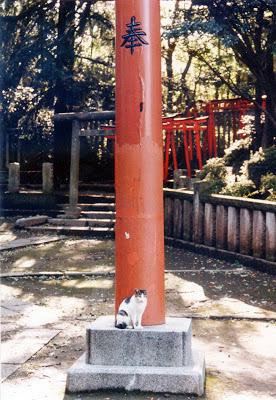
Stray cat in Nezu Shrine, which was (and probably still is) teaming with feral cats
I lived in the apartment for just one year, soaking in the history and aesthetic culture of Yanesen. During that time I photographed, painted and drew the buildings (most of the artwork now unfortunately lost), studied Japanese and worked on adapting my illustration portfolio for the Japanese market.
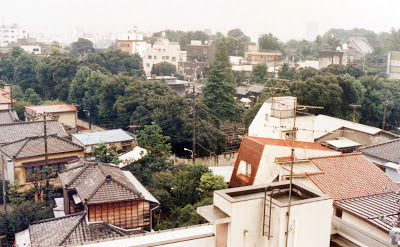
The view from my window towards Ueno, with Jomyoin Hakaen in the centre, top right can be seen the roof of the Kaneiji Temple
Yanesen was the perfect place for inspiration, I loved it to bits and would have stayed longer. However things were moving rapidly for me, and eventually escalating illustration commissions, relationships and other factors persuaded me very reluctantly to move uptown to the other side of the city. And there I stayed, much to my regret.
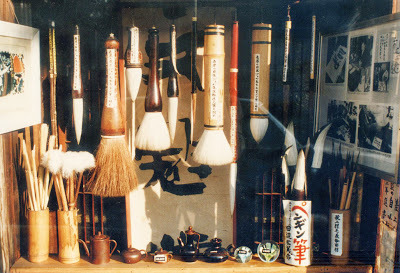
Very close to my apartment was the shop of a famous brushmaker
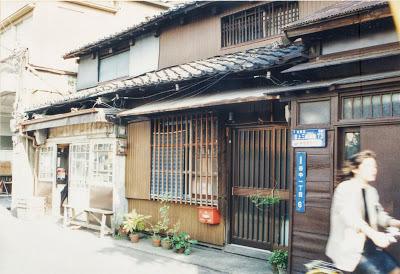
Yanaka 1Chome, 6 Banchi
Through the following years in Japan I moved home several times, but never went back to shitamachi to live. However, a couple of years after leaving the area I had the opportunity to once more walk around Yanesen. It was just two years since I'd lived there, but the change over that time was simply shocking. Several of the old wooden buildings I'd recorded had been torn down, replaced with ugly shoe-box buildings, or temporary car parks. A glaring 7-11 convenience store had opened on the top of Kototoi-dori. I was stunned - the character of the town was being torn apart.
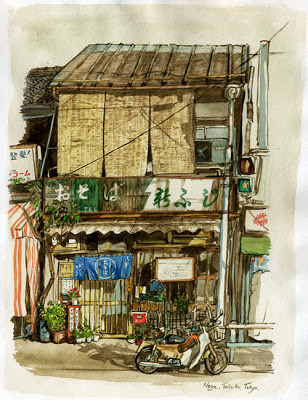
3rd generation Shin Fuji Soba restaurant, which stood close to Nezu Station on Kototoi-dori.
Watercolour sketch, Spring 1988
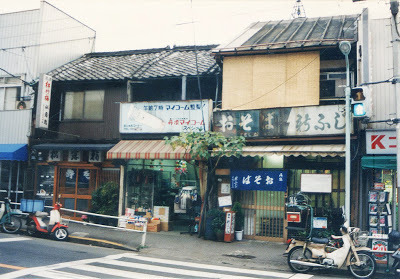
A photo I took of the same location in 1987
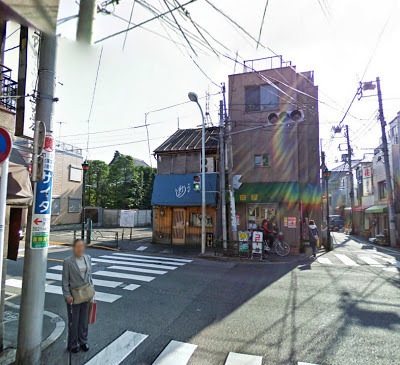
The same view today (from Google street view). The restaurant is still there (much spruced up!) but everything else around has changed.
On my most recent trip back to Tokyo this spring I had the chance to once more see a little of Nezu and Yanaka, 25 years after I lived there. It's still an attractive area, important buildings are just as I remember them, but so much of the rest has changed now the town was barely recognisable. This was one of the main reasons I never moved back to the region - the wanton destruction of the old architecture was just too
sad to witness. I understand that wooden buildings were difficult to live in, many were inefficient and rundown, but it is possible to preserve the facade while renewing interiors.
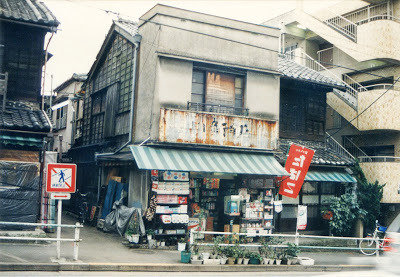
Kawasaki Shoten on Kototoi Dori, 1-15 Yanaka, in 1987
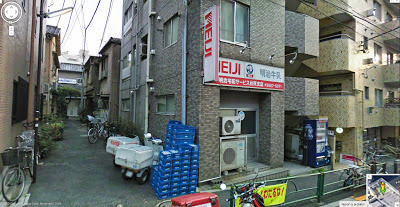
The same location today
It's not all bad news though, Yanaka and Sendagi attracts tourists, buildings are being saved by people dedicated to preserving something of the old town's atmosphere, Yanesen has become a haven for artists and others looking for a lost part of Japanese culture. Many of these artists are people from outside the area, including foreigners - it's ironic that the very people who 25 years ago would have found difficulty moving into the area are now those who are safeguarding it's old buildings.
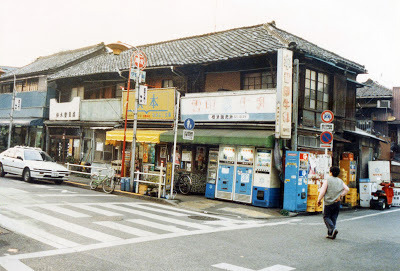
Nezu 2-Chome 33 Banchi in 1987 (my photo)
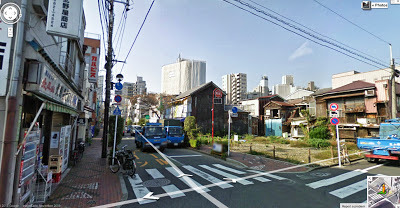
And the same location now (Google). Where's it gone!
Here I've posted some of my old photos from 1987-88, compared to Google street views of the same locations today. I've many more photos of the area, but virtually all my sketches from the period have been lost. If I find anything though I'll post it!
You can find more 'then and now' photos of the area by others comparing to the 1980's in this Japanese language blog.

A forgotten corner of Yanaka or Nezu in 1987
This actually proved more difficult than I'd imagined, as my very first residence, provided by my erstwhile sponsor, was right out on the very edge of Tokyo in a new town that was even younger than me. It took a few months before I could eventually find a place of my own choosing, by which time I'd had plenty of time to explore the old districts of the city. From the moment I first walked around Yanaka I fell in love with the area and knew this was where I wanted to live.

A typical scene in Yanaka in the 1980's. What is it like today I wonder?
The three districts of Yanaka, Nezu and Sendagi span the borders of Taito-ku and Bunkyo-ku wards, and together are known as the Yanesen district. Though part of the old city of Edo, Yanesen was always distinguished as a separate town of temples and shrines. Crucially, it was untouched by the 1923 earthquake and wartime bombing, so still retained much of it's ancient character, with numerous traditional wooden houses dispersed amongst the popular religious locations in the area. More residential and altogether more serene than the noisier jumble of other shitamachi (downtown) areas like Asakusa, Yanesen seems an oasis, full of cultural charm, surrounded by, but somewhat apart from the modern city, a bridge between old Edo and modern Tokyo, with a large number of traditional shops and businesses surviving. Or at least, so it was when I moved there in the Spring of 1987.

A favorite shop of mine, Isetatsu in Sendagi, famous as a specialist in Japanese paper. The shop is virtually unchanged today.

Memorial to one of my favorite Ukiyo-e woodblock print masters, Suzuki Harunobu (1725-70), and his muse Kasamori Osen (1751-1827), in Dai'enji Temple, Sendagi
Finding a place to live there was difficult though, because many rental real estate offices simply would not deal with foreigners, claiming they "had nothing available" before I'd even told them what I was looking for, or "the owners would not be comfortable". One even suggested I "try Roppongi". The fact was, few Westerners lived in the area and that's the way they wanted to keep it. Nevertheless I persevered, and eventually found an apartment in Ueno-Sakuragi, just off Kototoi-dori near Yanaka Cemetery, not an old traditional house as I'd hoped, but it was at least in the right region. I was a few minutes walk from Geidai and Ueno Park, Yanaka and Nezu were my local areas.

Stray cat in Nezu Shrine, which was (and probably still is) teaming with feral cats
I lived in the apartment for just one year, soaking in the history and aesthetic culture of Yanesen. During that time I photographed, painted and drew the buildings (most of the artwork now unfortunately lost), studied Japanese and worked on adapting my illustration portfolio for the Japanese market.

The view from my window towards Ueno, with Jomyoin Hakaen in the centre, top right can be seen the roof of the Kaneiji Temple
Yanesen was the perfect place for inspiration, I loved it to bits and would have stayed longer. However things were moving rapidly for me, and eventually escalating illustration commissions, relationships and other factors persuaded me very reluctantly to move uptown to the other side of the city. And there I stayed, much to my regret.

Very close to my apartment was the shop of a famous brushmaker

Yanaka 1Chome, 6 Banchi
Through the following years in Japan I moved home several times, but never went back to shitamachi to live. However, a couple of years after leaving the area I had the opportunity to once more walk around Yanesen. It was just two years since I'd lived there, but the change over that time was simply shocking. Several of the old wooden buildings I'd recorded had been torn down, replaced with ugly shoe-box buildings, or temporary car parks. A glaring 7-11 convenience store had opened on the top of Kototoi-dori. I was stunned - the character of the town was being torn apart.

3rd generation Shin Fuji Soba restaurant, which stood close to Nezu Station on Kototoi-dori.
Watercolour sketch, Spring 1988

A photo I took of the same location in 1987

The same view today (from Google street view). The restaurant is still there (much spruced up!) but everything else around has changed.
On my most recent trip back to Tokyo this spring I had the chance to once more see a little of Nezu and Yanaka, 25 years after I lived there. It's still an attractive area, important buildings are just as I remember them, but so much of the rest has changed now the town was barely recognisable. This was one of the main reasons I never moved back to the region - the wanton destruction of the old architecture was just too
sad to witness. I understand that wooden buildings were difficult to live in, many were inefficient and rundown, but it is possible to preserve the facade while renewing interiors.

Kawasaki Shoten on Kototoi Dori, 1-15 Yanaka, in 1987

The same location today
It's not all bad news though, Yanaka and Sendagi attracts tourists, buildings are being saved by people dedicated to preserving something of the old town's atmosphere, Yanesen has become a haven for artists and others looking for a lost part of Japanese culture. Many of these artists are people from outside the area, including foreigners - it's ironic that the very people who 25 years ago would have found difficulty moving into the area are now those who are safeguarding it's old buildings.

Nezu 2-Chome 33 Banchi in 1987 (my photo)

And the same location now (Google). Where's it gone!
Here I've posted some of my old photos from 1987-88, compared to Google street views of the same locations today. I've many more photos of the area, but virtually all my sketches from the period have been lost. If I find anything though I'll post it!
You can find more 'then and now' photos of the area by others comparing to the 1980's in this Japanese language blog.
Published on May 20, 2013 04:58
April 26, 2013
Recent Doodles
It's not just people sketching this Spring, I've been flexing the imagination as well.
These little sketchbook doodles are actually derived from real life. I bought a new bicycle recently, really. It doesn't look quite like this, but this is how I feel when I ride it.
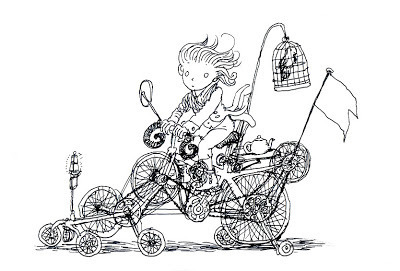
Daughter really, really, REALLY wants a pet. Something cuddly and furry.
I say, wait until we move house.
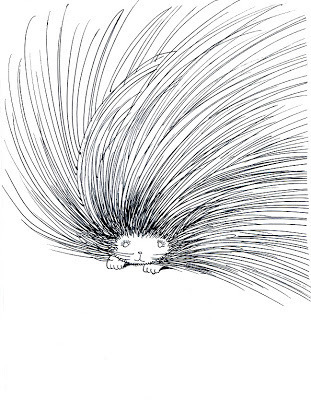
Ah yes, our new house! Our lovely new house! Now that's been on my mind a lot recently....
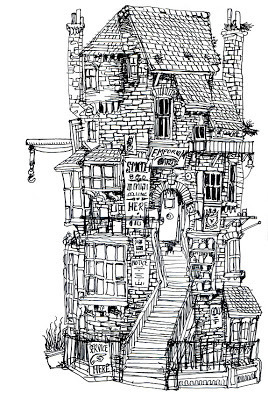
There are a lot of things on my mind lately.... somehow it all gets rather twisted when it gets put to paper.
These little sketchbook doodles are actually derived from real life. I bought a new bicycle recently, really. It doesn't look quite like this, but this is how I feel when I ride it.

Daughter really, really, REALLY wants a pet. Something cuddly and furry.
I say, wait until we move house.

Ah yes, our new house! Our lovely new house! Now that's been on my mind a lot recently....

There are a lot of things on my mind lately.... somehow it all gets rather twisted when it gets put to paper.
Published on April 26, 2013 10:32
April 20, 2013
April Tokyo Train Sketches Part 2
Here are some more sketches made earlier this month on Tokyo trains.
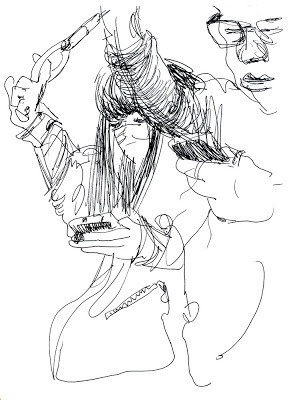
Den-en-Toshi line, evening rush-hour, yeay! I got a seat!
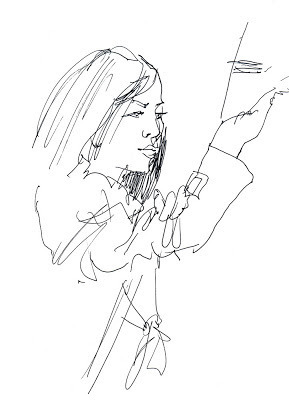
Den-en-Toshi line, evening rush-hour, These two drawings are the extent of what I could see from my seat
On this trip in particular I drew a lot of train passengers. Daughter and I were staying in familiar territory near Tama Plaza on the long Den-en-toshi line, which snakes from Chuo Rinkan in Yamato through the northern suburbs of Yokohama to the great hub of Shibuya, from whence it evolves into the Hanzomon line and continues eastwards through the middle of Tokyo. It takes around half an hour to travel on the express from Tama Plaza to Shibuya, but with the popularity of the suburbs beyond the Tamagawa river it's becoming increasingly difficult to get a seat, especially on the express even outside rush hours. It was often only when I caught the slower trains that I could sit and sketch.
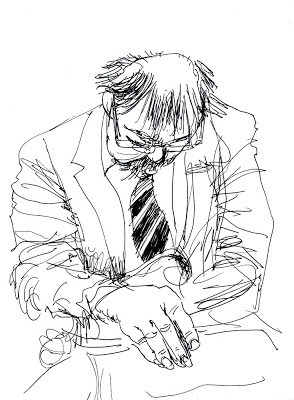
Den-en-Toshi line, end of the day.
Whenever I could find a seat though I would quickly pull out my sketchbook and pen and secretively sketch away, hoping not to attract attention, which is actually quite easy in Tokyo because many people shut themselves off into their own worlds on trains, ignoring all around them, playing games on their smartphones, reading, sleeping (or feining sleep).
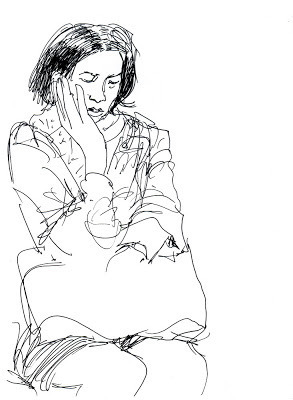
Hanzomon Line, daytime, Aoyama towards Shibuya
When will you get off? I don't know! You might change your position, or another passenger might suddenly block my view by standing in front. Quickly, rapidly I draw, secretly like a Ninja artist, seizing the fleeting moment. This kind of sketching exercise is full of excitement!!
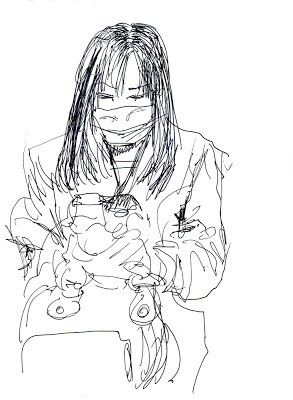
Ginza Line bound for Shibuya
And I wonder, we are all on our own private journey's brought together in this metal shell rushing through the city. We are all en-route, I pry into your lives with my pen, what insights can you offer? What are you thinking? Where are you going? Where have you been?
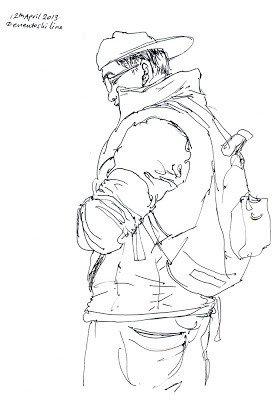
Den-en-Toshi line, en-route to Azamino
Dear train passenger models, muses of public transport system! I thank you!
This is my stop, I must be off! Farewell!
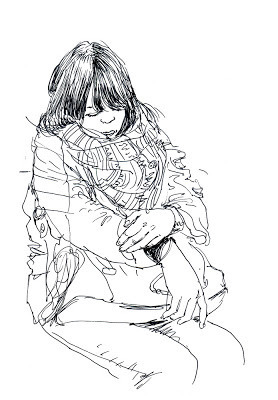
Den-en-Toshi line, en-route to Azamino

Den-en-Toshi line, evening rush-hour, yeay! I got a seat!

Den-en-Toshi line, evening rush-hour, These two drawings are the extent of what I could see from my seat
On this trip in particular I drew a lot of train passengers. Daughter and I were staying in familiar territory near Tama Plaza on the long Den-en-toshi line, which snakes from Chuo Rinkan in Yamato through the northern suburbs of Yokohama to the great hub of Shibuya, from whence it evolves into the Hanzomon line and continues eastwards through the middle of Tokyo. It takes around half an hour to travel on the express from Tama Plaza to Shibuya, but with the popularity of the suburbs beyond the Tamagawa river it's becoming increasingly difficult to get a seat, especially on the express even outside rush hours. It was often only when I caught the slower trains that I could sit and sketch.

Den-en-Toshi line, end of the day.
Whenever I could find a seat though I would quickly pull out my sketchbook and pen and secretively sketch away, hoping not to attract attention, which is actually quite easy in Tokyo because many people shut themselves off into their own worlds on trains, ignoring all around them, playing games on their smartphones, reading, sleeping (or feining sleep).

Hanzomon Line, daytime, Aoyama towards Shibuya
When will you get off? I don't know! You might change your position, or another passenger might suddenly block my view by standing in front. Quickly, rapidly I draw, secretly like a Ninja artist, seizing the fleeting moment. This kind of sketching exercise is full of excitement!!

Ginza Line bound for Shibuya
And I wonder, we are all on our own private journey's brought together in this metal shell rushing through the city. We are all en-route, I pry into your lives with my pen, what insights can you offer? What are you thinking? Where are you going? Where have you been?

Den-en-Toshi line, en-route to Azamino
Dear train passenger models, muses of public transport system! I thank you!
This is my stop, I must be off! Farewell!

Den-en-Toshi line, en-route to Azamino
Published on April 20, 2013 08:26
April 17, 2013
Tokyo on the Train
Daughter and I have just arrived home from another flying visit to Tokyo. As I was only in town for a couple of weeks it was a very busy time squeezing as much into each day as I could, most days spent zipping from one side of the city to the other. That's the way I like it though, Tokyo is a city in constant movement, it's a place to stay busy and on the move, a roaring metropolis. But it's also a place of fascination and beauty, filled with oases to dip into for much needed pauses.
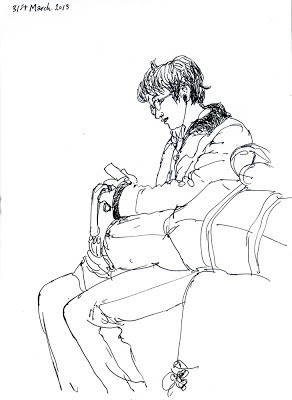
Denentoshi Line to Shibuya
What I love about Tokyo is the contrast, on the one hand there's the sense of being lost in the crushing urban wheels of the city (which in itself can be a very comforting feeling), and on the other there's the discovery of gems: galleries, shops, cafes and other beacons of serenity and joy. It's these details that make the difference, though the city is a turbulent machine, it's filled with portals of tranquility.
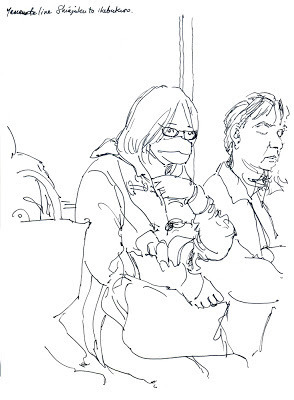
Yamanote Line between Shinjuku and Ikebukuro
On this trip though a lot of my moments of calm were spent on the train, sketching away. From uptown Yamate to downtown Shitamachi, from fashionable Aoyama to suburban Yokohama, I traveled, and observed my fellow travellers. And here are some of them.
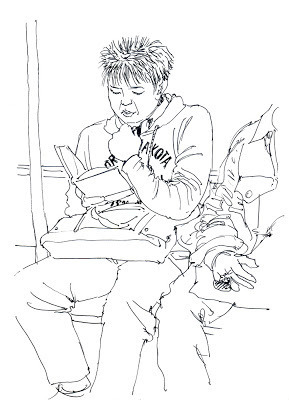
Chiyoda Line from Nezu to Meiji Jingumae
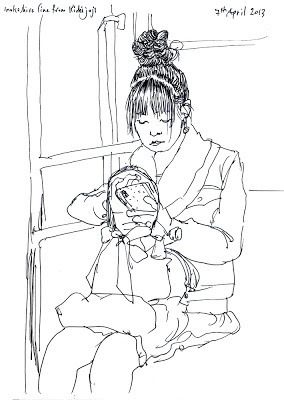
Inokashira Line from Kichijoji to Shibuya
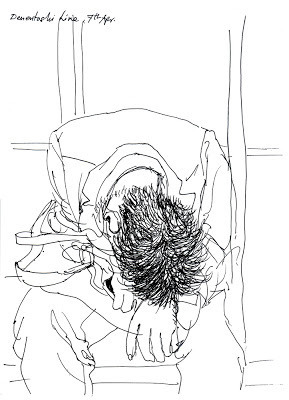
Late night train, Denentoshi Line to Tama Plaza
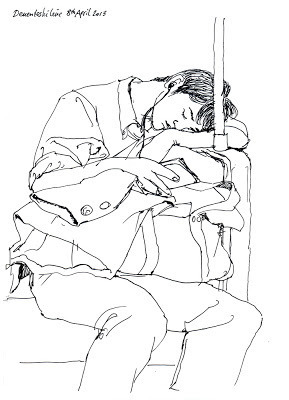
Dozing highschool student. Morning train, Denentoshi Line to Shibuya

Denentoshi Line to Shibuya
What I love about Tokyo is the contrast, on the one hand there's the sense of being lost in the crushing urban wheels of the city (which in itself can be a very comforting feeling), and on the other there's the discovery of gems: galleries, shops, cafes and other beacons of serenity and joy. It's these details that make the difference, though the city is a turbulent machine, it's filled with portals of tranquility.

Yamanote Line between Shinjuku and Ikebukuro
On this trip though a lot of my moments of calm were spent on the train, sketching away. From uptown Yamate to downtown Shitamachi, from fashionable Aoyama to suburban Yokohama, I traveled, and observed my fellow travellers. And here are some of them.

Chiyoda Line from Nezu to Meiji Jingumae

Inokashira Line from Kichijoji to Shibuya

Late night train, Denentoshi Line to Tama Plaza

Dozing highschool student. Morning train, Denentoshi Line to Shibuya
Published on April 17, 2013 07:05



